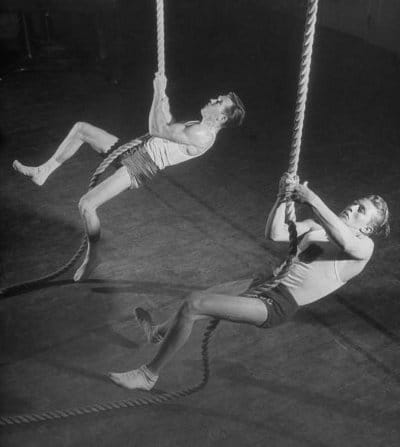
Editor’s Note: This is a guest article by Reese Dockrey.
Things don’t always go as planned in the life of a lifter. On a long enough timeline, it’s guaranteed that some unforeseen event will interrupt your training. Maybe it’s an injury that sidelines your workouts for several weeks. Or you have a baby, and suddenly there’s no time to get “the pump” on for a few months. Or there’s a worldwide pandemic that forces your gym to shut down for an extended period of time.
Then, in the following weeks, the consequences kick in: you start losing the gains you worked so hard to build, and you begin shrinking down to your old self. Maybe you pick up a basic bodyweight routine at home, but you know that pushups and lunges won’t be enough to replace a barbell and squat rack.
When this happens, a lot of guys go into panic mode, understandably. The fear of knowing that you have to “use it or lose it” sets in. Even when you’re finally able to get back into the gym, you remember how hard it was to build up your body, and you dread the thought of having to do it all over again.
Thankfully, the situation isn’t so dire. The fact is, guys who lose muscle are typically able to gain it all back quickly, i.e., you’re not starting from square one. Before diving into how this works, let’s take a quick refresher on how you were able to build all of that muscle in the first place. Here’s the CliffsNotes version:
- Strength training with heavy weights puts a stress on your body, which stimulates a response that “tells” your body to adapt to the stress by getting bigger and stronger.
- You recover from that stress via diet—with lots of calories and protein—and plenty of rest.
- As you recover, you experience “hypertrophy,” which is an increase in the size and/or density of individual muscle fibers.
The Key to Your Comeback: “Muscle Memory”
In strength training, “muscle memory” has long been understood as the body’s ability to “remember” certain movements. Basically, as you build muscle, your neural networks get more efficient at moving heavy loads in specific patterns. When you stop working out for a while (aka “detrain”), you lose some of that strength. Then, when you resume lifting (even years later), like remembering how to ride a bike, you quickly recover your nervous system “gains.”
Even your DNA remembers. A 2018 study found that, even after detraining for several weeks (and potentially years), your “epigenetic” ability for hypertrophy isn’t lost, i.e., if you get swole once and lose it, you can get swole more easily the second time around.
Then there’s your muscle cells and their multiple nuclei — called “myonuclei” — which are sort of the “control centers” of the cell. Each myonuclei can handle only a certain amount of muscle within the cell, so for the muscle cell to continue to grow over time, it needs more myonuclei. When you train, your individual muscle fibers acquire these additional myonuclei from nearby “satellite cells,” and BOOM, you get massive pecs and traps. In a 2010 study of mice, researchers at the University of Oslo discovered that after you stop your workouts and your muscles atrophy, those additional myonuclei tend to stick around — potentially for years.
That’s all to say: you’ve already done the hardest part!
Simply put, adding more myonuclei to your muscle fibers and strengthening your nervous system is like upgrading your car with a new engine. It was a Honda Civic before, but now it runs more like a Lambo. Even if you stop driving it for a while — and the gas tank dries up, and the battery loses power — you still have a supercar sitting in the driveway, waiting to be brought back to life.
How Quickly Gains Are Lost
You didn’t start shrinking after only a few days of not working out. In fact, it takes about 3-4 weeks of not training a certain muscle group before the muscle begins to break down.
According to a meta-analysis by the experts at Legion Athletics, here’s what else you’ll lose:
- Glycogen. After 4 weeks of detraining, your glycogen levels, which contribute to muscular size, might be cut in half.
- Your strength. This might begin to decline after 3 weeks. Your lifting form will likely break down even sooner, which is why you might feel weaker after only several days of detraining.
- Muscle fiber nuclei. After about 3 months, you might start losing it. That’s if you lose it at all.
These estimates assume you continued eating enough protein and calories (i.e., you weren’t in a caloric deficit) and stayed relatively active during your break.
You’ll also see a decline in your athleticism and general health. In an article analyzing the effects of a 4-week detraining period on endurance athletes, strength coach Carmen Bott observed some common outcomes: a decline in V02 max (i.e., less aerobic endurance), lower insulin sensitivity, reduced ATP production (i.e., less energy), and muscle atrophy. She noted that, essentially, the more well-trained you are to start, the faster your decline will be. On the plus side, it was found that strength can be maintained for the first month of detraining.
A 2013 study of both rugby and football players showed that strength levels can be maintained for up to 3 weeks of detraining. The rate of strength decay accelerates thereafter (weeks 5-16).
Age is an issue too. Basically, the older you are, the quicker you’ll lose muscular strength as you detrain. A 2000 study observed 2 groups as they detrained for 31 weeks: the younger group (age 20-30) lost around 8% of their 1RM (one-rep max) strength, while the older group (age 65-75) lost closer to 14%.
Therefore, regardless of age or training experience, and even if your diet was on point, you probably lost a little size and athletic ability after a month of detraining. After a few months, you might have lost a lot.
How Long Does It Take to Rebound?
Since you’ve detrained for months (or even years), you now have insane potential for muscular growth. Remember those sweet “noob gains” you had when you first started lifting, when you were able to add 50 pounds to a lift in a month? Well, you’re not an actual beginner again, but you’re in a similar position. Your gains will come back at an alarming rate.
According to the research of pro bodybuilder Jeff Nippard, the timeframe to get your muscle gains back is typically around half the time you took off. So, if you had a 2-month break from lifting, it might take just a month to get all of your gains back. Took six months off? You’ll need three months to gain it all back.
It might come back even faster. Sports scientist Greg Nuckols noted that a 3-month detraining period might require a month or less to regain all of your lost muscle.
This timeframe works well if you’ve been off for a period of months, but if you’ve detrained for many years, there’s no formula to tell you how quickly you’ll get it all back.
Of course, you can’t suddenly jump right back into whatever training you were doing last. This is for a few reasons:
- You’re not as strong as you were (regardless of what your ego might tell you).
- Your body isn’t capable of recovering from suddenly lifting heavy again.
- Your good form will largely be lost, and it might feel like it’s your first time touching a barbell.
How to Train to Regain ASAP
If you’ve detrained for years, you’re not starting from scratch, since you have muscle memory. Still, if you lost most of your gains in that time, you’re almost back to being a beginner (aka “novice”). You’ll do best to follow a basic barbell beginner program, such as Starting Strength or Strong Lifts 5×5. The weight will be light enough for the first few weeks that you should have no issue with being overly fatigued.
But let’s address the guys who detrained for months, not years.
You need to slowly ease back into training heavy by reducing intensity, volume, and frequency. That is, lift lighter weights, for fewer sets and reps, during the course of fewer workouts per week. This period should last only 2-4 weeks before you can resume training hard again. This will give your body time to make a host of necessary improvements, including revitalizing your neurological efficiency and your “mind-muscle connection,” which is simply your ability to mentally engage each muscle group. Put simply, you need to get some practice in before getting back into the game. Here are some guidelines to keep in mind:
Reduce the intensity. You shouldn’t start with the weight you used last, as your body isn’t capable of recovering from it. You definitely don’t need to be maxing out or doing super-heavy, low-rep sets. Don’t lift to failure, either. Always keep a few reps in the tank, especially on the compound lifts. With isolation lifts, you can go closer to failure.
Reduce the volume. It’s best to stick with sets of 5-12 and perhaps only 2-4 sets per lift. Similar to when you were a beginner, the 5-rep range might be best. It tends to be the perfect middle ground, allowing you to meaningfully test your strength without going too heavy, and providing enough volume without overtaxing your body. Also, be sure to rest plenty between sets, as you might have lost a lot of cardiovascular endurance during your break.
Like normal training, you should still be making your workouts harder each time, but you might do best to avoid adding weight for the first week or two. Instead, make things harder with slow reps, drop sets (not to total failure), pause sets, etc. Your muscles need only a little nudge right now, not a sledgehammer.
Reduce the frequency. Hitting each muscle group 2-3 times per week should be plenty. Once per week might not be enough to gain back muscle and strength quickly, and more than 2-3 times per week can lead to unnecessary volume and soreness. Either a push-pull-legs or upper-lower routine should be perfect for this. You can easily get all of the necessary volume in just 2-3 workouts per week, 30-60 minutes apiece.
Exercise selection. To avoid muscle soreness, which is very common when coming back from a detraining period, you might avoid lifts that require a big stretch, such as lunges, Romanian deadlifts, and good mornings. Whatever lifts you choose, you want to really feel the muscle being worked and to allow for a good pump. This means cables and machines will be your friend as you ease back into training. You should still use heavy compound lifts like bench, (conventional) deadlifts, and squats, but with light weight.
After 2-4 weeks, once your strength and form improve, you can get back to lifting hard and heavy. From that point on, do whichever program works for you, so you can gain back muscle fast: powerlifting, bodybuilding, etc.
Of course, to gain that muscle back quickly, you have to eat right, and how you should eat depends on what happened to your body since you stopped lifting.
How to Eat as You Get Back into Training
As you were forced to pause your workouts, you likely let your diet slip. That’s okay; it’s hard to stay motivated to eat healthy when you don’t have any planned lift sessions to put those calories to good use. This means your body composition (i.e., your fat to lean mass ratio) has changed, and you might need to eat differently than before.
If you continued working out at home during your break — perhaps an advanced bodyweight or dumbbell routine — then you might have kept most if not all of your muscle. If you also ate maintenance calories, then your body composition basically hasn’t changed. For the sake of this article, however, I’ll just assume you didn’t work out hard and that you did lose muscle.
While detraining, naturally skinny guys who tend to undereat (aka “hardgainers”) will typically reduce calories from a bulk to their natural low-calorie eating habits. Then, they’ll lose weight — all muscle loss — while their body fat stays the same.
Most other guys will lose muscle and gain fat simultaneously as they detrain. If they ate maintenance calories, they simply experienced a “body recomposition” for the worse (i.e., they lost muscle and gained a higher body fat percentage, with no change in weight). If they overate during their break, they lost muscle and gained weight (all fat gain).
Now let’s discuss the pros and cons of three dieting methods to choose from.
Eat at a Calorie Deficit (aka “Cut”)
This is best for anyone who became significantly overweight during their hiatus. On the bright side, your excess calories likely helped you maintain more muscle than other guys. Since you’re now overweight and potentially obese (BMI over 30, or body fat over 25%), you can lose weight and build muscle simultaneously.
Reduce eating by 20-25% of your maintenance calories. If you don’t know your maintenance calories, estimate them using a free online “TDEE calculator.” Or even better, track your normal food intake for a week, then divide the total calories by the number of days. If you’re a bigger guy (200 lbs plus) aim to lose 2 lbs per week. If you’re smaller, aim for closer to 1-1.5 lbs per week. This way, you’ll burn fat as fast as possible without losing muscle.
Eat lots of protein, at least one gram per pound of bodyweight. Even more protein is probably better during a “cut,” and yes, it’s safe. You can reduce carbs significantly, and try to eat most of your carbs before and after workouts. Aim to get at least 80% of your diet from “clean,” whole foods.
After a few weeks (or months), when your weight and body fat percentage are below obesity levels, you can increase calories to maintenance to achieve slow muscle gains while continuing to lean down. Or, continue cutting until you’re leaner; then you can increase calories to a small surplus to build muscle even faster.
Eat Maintenance Calories (aka “Body Recomposition”)
This is best for the guys who gained body fat but aren’t obese. Since you don’t have a ton of extra weight that would allow you to gain significant muscle on a “cut,” your best option is to eat maintenance calories. Your bodyweight should stagnate, but your body fat percentage will drop while you build a little muscle. The fat loss will be slower than it would be with a “cut,” so you might need several months to get lean. Again, keep protein high and eat “clean.” Once you’ve leaned down, or you’re just ready to get faster gains, you can start bulking up.
Eat at a Calorie Surplus (aka “Bulk”)
This is best for anyone who is at a healthy weight and body fat level, and who wants to build muscle as fast as possible. If you’re older (35+) or you gain weight easily, increase your intake by 10-20% of maintenance calories. You want to regain muscle fast while minimizing the fat gain. Expect to gain roughly 0.5-1 lb of bodyweight per week, most of which should be muscle gains.
If you’re a young, skinny “hardgainer,” you probably became underweight as you detrained. Due partly to your hyper-fast metabolism, you’ll require even more calories to bulk up. You have the potential to gain a ton of muscle as your body fills out. You might need a 1,000-calorie surplus or more. Expect to gain 1-2 lbs per week, and aim for a muscle-gain to fat-gain ratio of 1:1 or better. Once your body fills out to a normal weight, you can reduce calories to a smaller surplus for slow and steady gains.
All bulkers should eat lots of protein and calorie-dense, whole foods. If you tend to have a hard time gaining weight, eat plenty of carbs. If you gain fat easily, use carbs sparingly, and try to get most of them before and after workouts. Whenever you get uncomfortable with the fat gains, reduce to maintenance calories to lean down.
All you have to do now is make a plan for your workouts and your diet and just show up and do the work; the gains will come back in no time.
______________
Reese Dockrey is a land surveyor and a former “skinny guy” who struggled his entire life to gain muscular size and strength. His physical transformation from scrawny to swole (and the mountain of research it required) inspired him to share that knowledge with other men who need it. His website is scrawnytoswole.com and his book, Scrawny to Swole, is available on Amazon.







